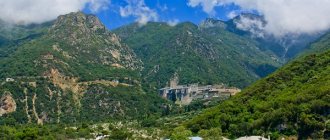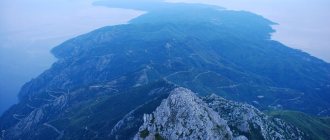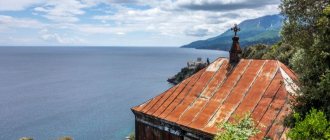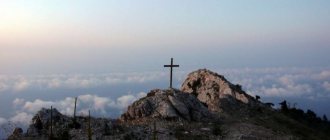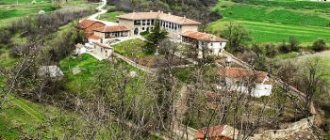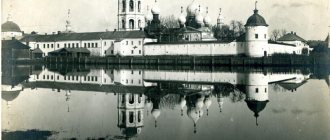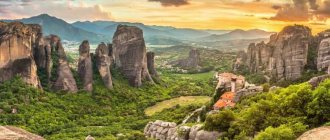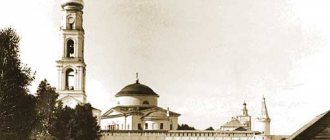At the mere mention of Greece, many associations pop up in your head about great philosophers, discoveries, words that have penetrated into all languages of the world, myths and ancient Greek gods, familiar to everyone from school.
The Greeks are known not only for their love of life, but also for their deep faith and reverence for traditions. They call themselves descendants of the great Byzantine culture, and most of them profess Orthodoxy.
More than 90 percent of the indigenous population recognize themselves as Orthodox Christians.
The Greek Constitution calls Christianity the state religion, while leaving the right to choose religion to the citizens themselves, excluding the possibility of conducting missionary activities.
Representatives of different faiths coexist peacefully with each other. A significant part of Muslims are concentrated in Rhodes; Catholics are often found on the Aegean Islands; there are Protestants, Jews and those who continue the faith of the ancient Greeks in the gods of Olympus.
History of the emergence of the Greek (Helladic) Orthodox Church
Officially, the Greek Church is one of the youngest in the Orthodox world. But the history of Christianity in these lands goes back 2 thousand years.
Base
Orthodoxy was brought to the Greek lands by the Apostle Paul. Arriving on the Macedonian coast, the preacher addressed the Word of God to the residents of the cities of Kavala and Philippi. In the latter city, under the influence of the apostle’s preaching, the family of a wealthy city dweller, Lydia, was baptized. They were the first Christians on the European continent.
Saint Apostle Paul was the first missionary to Greek lands
Then the beloved disciple of Christ went south, where he converted the inhabitants of Athens, Thessaloniki and Corinth to the true Faith. He bordered these communities until the end of his earthly journey. Also, Christianity was spread in Greece by the apostles Luke, John the Theologian and Andrew the First-Called.
A century later, Christian communities spread throughout Greece. Until the 9th century. submitted to the authority of the Bishop of Rome. At the same time, from the middle of the millennium, the young Byzantine state began to influence the Peloponnese. Officially, the Greek dioceses became part of the Patriarchate of Constantinople. At the same time, the center of Orthodox monasticism was born on the island of Athos.
The Middle Ages were a testing time for the Greek Church. During the Early Middle Ages, Orthodoxy was persecuted by the Crusaders. From the middle of the 15th century. the entire territory of the Balkan Peninsula fell under the yoke of the Ottomans, who defeated the Byzantine Empire.
Important! For almost 400 years, Christians died at the hands of the Ottoman Muslims. At the same time, it was the clergy who made a lot of efforts to preserve Greek traditions, language and national identity. They led the popular resistance, which led to the overthrow of Ottoman rule and the formation of an independent Greek state.
Declaration of Independence
In 1833, on the initiative of the secular authorities, the autocephalous Greek Church was formed. The ruling monarch was proclaimed its head. This organization was not recognized by either the Ecumenical Patriarch or the Local Churches until 1850.
Over the next 100 years, the territory of the local church, as well as its internal traditions, took shape. The Second World War brought new challenges to the Greek clergy: a shortage of priests, a large number of destroyed churches. Under these conditions, the state government took upon itself the care of the Orthodox Church. The 1975 Constitution officially established the state status of Orthodoxy.
Monastery of St. Anastasia the Pattern Maker
Not far from the monastery of St. John the Evangelist, in the Chortiatis mountains, the monastery of St. Anastasia the Pattern-maker , which still functions today as a functioning monastery, where the relics of St. Anastasia herself are kept.
It is completely different from the welcoming and well-groomed Monastery of St. John the Theologian, but it fascinates with its special, slightly harsh and very ancient atmosphere, telling about the thousand-year history of the monastery.
From its walls, as hundreds of years ago, there is a view of the Macedonian valley, even now almost untouched by civilization.
Hierarchy of the Greek Orthodox Church
The church hierarchy is also enshrined in the main state document of Greece. In accordance with it, the main governing body of church institutions is the Holy Council, which consists of the heads of all Greek dioceses holding the rank of metropolitans.
Jerome II - Archbishop of Athens and All Greece
They are appointed by the government of the state. The meeting of bishops elects a head who receives the title of Archbishop of Athens and All Greece. The chosen clergyman must be approved by the head of state within 5 days, after which a solemn enthronement is scheduled.
On a permanent basis, church affairs are governed by the Holy Synod, consisting of the Archbishop of Athens and 12 metropolitans. They occupy the post on a shift basis.
The modern Greek Church consists of 81 dioceses. It is believed that 30 of them are under the jurisdiction of the Ecumenical Patriarch. It should be noted that the territories of the islands of Crete, Dodecanese and Athos, which politically belong to Greece, are under the direct control of the ruler of Constantinople.
Interesting! The division into ancestral and new lands is reflected in the composition of the Holy Synod. 6 out of 12 metropolitans represent dioceses belonging to the jurisdiction of Constantinople.
Monastery of Saint Dionysius
For those who have one more day left, a trip to Mount Olympus, to the ancient monastery of St. Dionysius (XVI century), will be unforgettable.
The monastery is hidden in the mountains on the slopes of the gorge and it is not easy to find it even in our time, and before, until the road was built, it was almost impossible: during the period of the Turkish yoke, the monks, seeking peace and security, went far away from the Muslims into the mountains.
The monastery was blown up by the occupiers during the Second World War, and restoration work is still underway, but the temple itself and the refectory are already open to the public.
The Monastery of St. Dionysius on Olympus is very difficult to find
Before founding the monastery, St. Dionysius lived as a hermit in one of the caves of Mount Olympus, where he died in 1541.
A path leads from the monastery to a cave, where a miniature church is now located - a place of constant pilgrimage for Christians.
A hike to the cave along a mountain path for people not accustomed to physical activity can be regarded as a small feat of faith... the journey takes about half an hour one way.
The relics of Saint Dionysius were transferred to the monastery he founded, where they now rest, in the left vestibule of the temple.
In the courtyard of the temple you will find a consecrated mountain spring with cold drinking water, which gives pilgrims new strength both in hot and cold weather...
Differences between Greek Orthodoxy and Russian
The Russian and Greek people are co-religionists. Orthodoxy in Russia and Greece have common dogmatic foundations and service canons. Minor differences lie in the external ritual attributes of the Faith.
Priesthood status
Russian tradition distinguishes ministers of the Church into a special class. Often they distance themselves from ordinary lay people, communicating with them only within church walls. At the same time, the attitude towards clergy in Russian Orthodoxy is characterized by some indifference. Priests and monks in Greece are closer to the common people, being part of them.
Orthodoxy is the official religion in Greece
You can approach them on the street and ask for a blessing. Often after the service, the priest and parishioners sit down at a common table and have tea. At the same time, the Greek servants of the Lord, regardless of age, enjoy universal respect. Even a young man in a cassock will be given a seat in a transport, or a blessing will be asked on the street.
Robes and external attributes
The vestments of Russian priests are distinguished by splendor and richness. Depending on the service, clothes of different colors are used. Greek clothes are characterized by minimalism and laconicism. On special occasions, white robes are used.
The cross in the Russian tradition is an indicator of the status of a clergyman. In accordance with this, the appearance of this Christian symbol differs. For Greek clergy, the cross is a reward for diligent service. It is not worn in everyday life, being worn only for bishop's services.
The opposite situation occurs with the headdress - kamilavka. The Greek headdress is a part of the everyday vestment of a priest. It is produced only in black and has an extension at the top. Kamilavka in Russia is a reward. It is a cylinder-shaped headdress, the color of which depends on the type of service.
Service traditions
Worship in Greece lasts 1-1.5 hours. Most of the service is held with the Royal Doors open in full view of the parishioners. Greeks try to take communion weekly. The lowest church dignitaries, deacons, have the right to receive communion. At the same time, the laity undergo the sacrament of confession 3-4 times a year.
The Bible in the Greek Church differs in the composition of its books from the Church Slavonic
The procession of the cross in the Greek Orthodox tradition is accompanied by the sounds of a brass band. He walks through the streets to the central square of the settlement, where a solemn prayer service is being held. The holiday ends with folk festivities and fireworks.
Greek holy places
Connoisseurs of Ancient Greece come to the country to see museum exhibitions and the famous Parthenon; tourists choose the beaches to take a break from the hustle and bustle and soak up the sun.
Pilgrims strive to get in touch with those places from where Orthodoxy came to Russian soil, to find solitude and make a prayer request.
Greek church ministers are loyal to all parishioners: both those who are strengthened in faith and those who take their first steps. They are always friendly and welcoming.
In temples there are more relaxed rules: you are allowed to sit, special chairs are installed for this, and women are allowed to appear in trousers and without a headscarf.
At the same time, a dress that is too loose will be considered disrespectful. The Greeks do not prioritize external things; for them, the most important thing is the internal power of faith and prayer.
Russia and the Greek Church: history of relationships
The Russian and Greek Churches are closely connected with each other. Their relationship went through several stages.
- At the initial stage, the Greek Church played the role of a guide to the Christian world for the Russian lands. She contributed to the formation of a state on the territory of the Eastern Slavs. The first leaders of the Russian Church were of Greek origin.
- The situation changed after the conquest of Byzantium by the Ottomans. Russia by this time had strengthened its position and began to provide patronage to the Greek clergy. In the XVII-XVIII centuries. More often than not, financial support was refused. By the end of the 18th century, Russia was providing active military assistance to the national liberation movement in the Balkan countries.
- Today, the relations of co-religionists are strongly influenced by the global political situation. The schism began in 2021, after a split broke relations between the Russian Orthodox Church and the Patriarchate of Constantinople, which has a strong influence on the Greek Church. In this regard, Russian priests are prohibited from holding joint services with the Greek clergy.
Rock temple of St. Paraskeva
Our last goal is the Tembi gorge with the small rock temple of St. Paraskeva .
When driving through Tembi, be careful not to miss the only parking lot in the town of Agia Paraskevi, from which you can cross the suspension bridge to the other side of the gorge to the temple.
According to Tradition, it was in this gorge that Saint Paraskeva of Rome, a Christian martyr of the 2nd century, considered a healer of eye ailments, was arrested.
Here, at the beginning of the 20th century, during the construction of the railway, an icon of the saint was miraculously found.
Those seeking healing, as well as all believers who came to venerate Saint Paraskeva, go to venerate the source. To do this, they need to literally go inside the rock along a short but narrow passage. Only two people can pass there, so it is better to quietly and patiently follow the line.
To the saints with a request
Women suffering from infertility tend to visit the church in Tsalebiko in Rhodes. There, the temple of Maria Tsambika is located on a mountain, at the foot of which you need to visit the chapel where candles with the image of a baby are made. While the placed candle is burning, the women prayerfully ascend to the temple itself along a very high staircase.
The Paliani convent in Crete is the oldest; the main shrine is the myrtle tree, which, according to legend, grew from the icon of the Virgin Mary. The face of Saint Mary may appear in the branches, but only to sincerely believing sinless people. Many pilgrims write notes, light candles, leave gifts near the tree and in every possible way contribute to the prosperity of the monastery.
To Greece for a cure for an illness
The Meteora complex on Holy Athos is the mountain where Mary spent her earthly life, and currently contains about 20 monasteries. Various relics are carefully kept here - the Belt of the Virgin Mary, the Holy Gifts, the relics of the apostles and holy elders. The Monastery of St. Panteleimon is also located here. You can guess and buy a tour to Greece for July 27, when Remembrance Day is celebrated and a religious procession takes place, and thousands of believers suffering from incurable illnesses try to venerate the miraculous icon and receive hope for recovery.
Among Russian tourists, the Church of St. John the Russian in the village of Neo Prokopio on the island of Euboea enjoys special veneration, which was known for its piety and ability to heal the sick with the word of God. Pilgrims flock here to this day, and the list of newly revealed miracles and deliverances after visiting the temple is carefully updated by the abbot, thereby confirming the reality of the events.
Nunneries in Meteora
In northern Greece there is the large monastic complex of Meteora. It is located in a picturesque location on the rocks in the mountains of Thessaly. Many of the monasteries have long been destroyed and are of only historical value. But there are also active communities in which the spirit of prayer and piety does not fade.
Monastery of St. Barbara
Among the sacred Meteora monasteries is the monastery of St. Barbara, which also has another name: Rusanu. Why it was called that is not known exactly.
There are several versions of the origin.
- According to one of them, the founders of monastic life at this place in 1288 were two hieromonks Nicodemus and Benedict.
- According to another, the monastery was founded by a certain man named Rusanos, who came from the town of Rusana. Perhaps this was the first inhabitant or architect of the temple.
For an unknown reason, the monastery soon ceased to exist. And only in 1527, the brothers Maxim and Joseph, originally from the city of Ioannina, settled on this place, receiving the rock and everything on it from the bishopric of Stagon. The new monks began their monastic path with the construction of a temple in honor of the Transfiguration of Christ.
The monks lived and worked in this holy place until 1940, but were forced to leave the walls of the monastery. After their departure, a single nun, Eusevia, settled here completely alone. Through daily prayers and efforts, she, on her own, maintained order and life in the monastery buildings for 20 years, until her death.
Monastery of St. Barbara
After reconstruction work, the monastery was refounded and given to the female monastic community, named in honor of the Holy Great Martyr Barbara.
The stone walls of the monastery buildings seem to be the natural end of a small rock. From the bridge that leads to the entrance to the monastery, well-groomed flower beds are visible. Rusanu is famous for its paintings; they date back to 1560 and are only 30 years younger than the monastery walls themselves. Inexorable time has not preserved the names of talented icon painters. But he failed to erase the bright faces of the ancient saints from the walls.
From the monastery of Rusanu, due to its special location, other Meteora monasteries are visible. From its walls a pilgrim can see the grandeur of unique landscapes. In this blessed place, every believer feels such a spiritual uplift, as if he were in front of the heavenly gates, opening the entrance to the heavenly world.
Monastery of St. Stephen
This is the richest monastery in the Meteora monastery complex. In addition, it is the most accessible for pilgrims to visit. Located on a high cliff, near the city of Kalambaka. One of its slopes is equipped with an eight-meter pedestrian bridge, along which you can get to the top.
At the beginning of the last century, before it was built, monks and visitors to the monastery, as well as building materials, things, products, could only get to the top using hanging wooden ladders or special nets that were manually pulled up.
The construction of the monastery dates back to the end of the 14th century. It was founded by Anthony Katakuzinos and Philotheus of Siatinsky, whose images are depicted on the walls of a small church. In the mid-16th century, the Patriarch of Constantinople declared the monastery stauropegial.
Monastery of the Holy First Martyr Stephen
By the end of the 19th century, the monastery was for men; there were just over thirty brethren in it. Throughout the 20th century, it was repeatedly subjected to destruction and desecration. During the Great Patriotic War, it was repeatedly bombed and plundered by German and Italian occupiers.
The monastery also suffered during the Civil War. However, Meteora soon began to turn into a major tourist attraction and life began to fill them in full swing.
By 1960, the time of revival, the monastery was already almost empty, and its new life began as a convent. The most significant monastery relics include:
- ancient portable icons of the 17th-18th centuries,
- paten with chalice,
- a recording of the Divine Liturgy dated 1404 and made by one of the founders of the monastery.
The monastery conducts active educational activities, promoting the revival of Byzantine music and teaching iconography.
